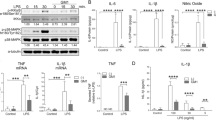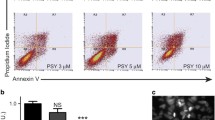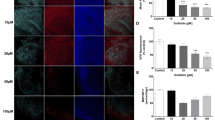Abstract
Cytotoxic capacity of psychosine (galactosylsphingosine) was evaluated in comparison with C6-ceramide in cultured fibroblasts and the glia-derived MOCH-1 cells that have characteristics of myelinating cells (1). Psychosine caused cytotoxic cell death and DNA fragmentation at concentrations similar to C6-ceramide and MOCH-1 cells were substantially more sensitive to their cytotoxic effects than fibroblasts. In this system, pretreatment with GM1-ganglioside failed to protect the cells from the deleterious effects of these compounds. These findings are consistent with the hypothesis that psychosine is the cytotoxic metabolite that causes apoptotic death of the oligodendrocyte in globoid cell leukodystrophy (Krabbe disease). They further suggest that the protective capacity of GM1-ganglioside is unlikely to be the explanation for the paradoxical improvement of the phenotype of globoid cell leukodystrophy in the mouse simultaneously deficient in two lysosomal β-galactosidases, galactosylceramidase and GM1-ganglioside β-galactosidase.
Similar content being viewed by others
REFERENCES
Hayes, C., Kelly, D., Murayama, S., Komiyama, A., Suzuki, K., and Popko, B. 1992. Expression of the NEU oncogene under the transcriptional control of the myelin basic protein gene in transgenic mice: Generation of transformed glial cells. J. Neurosci. Res. 31:175–187.
Taketomi, T. and Nishimura, K. 1964. Physiological activity of psychosine. Jap. J. Exp. Med. 34:255–265.
Sugama, S., Kim, S. U., Ida, H., and Eto, Y. 1990. Psychosine cytotoxicity in rat neural cell cultures and protection by phorbol ester and dimethyl sulfoxide. Pediatr. Res. 28:473–476.
Igisu, H. and Nakamura, M. 1986. Inhibition of cytochrome c oxidase by psychosine (galactosylsphingosine). Biochem. Biophys. Res. Commun. 137:323–327.
Igisu, H., Matsuoka, M., and Hamasaki, N. 1990. Binding of galactosylsphingosine (psychosine) by albumin. Lipids 25:65–68.
Hannun, Y. A. and Bell, R. M. 1987. Lysosphingolipids inhibit protein kinase C: Implications for the sphingolipidoses. Science 235:670–674.
Wenger, D. A., Suzuki, K., Suzuki, Y., and Suzuki, K. 2001. Galactosylceramide lipidosis: Globoid cell leukodystrophy (Krabbe disease), Pages 3669–2694, in Scriver, C. R., A. L. Beaudet, W. S. Sly, and D. Valle (eds.) Metabolic and Molecular Basis of Inherited Disease, McGraw-Hill, New York.
Miyatake, T., and Suzuki, K. 1972. Globoid cell leukodystrophy: Additional deficiency of psychosine galactosidase. Biochem. Biophys. Res. Commun. 48:538–543.
Suzuki, K. 1998. Twenty five years of the psychosine hypothesis: A personal perspective of its history and present status. Neurochem. Res. 23:251–259.
Taniike, M., Mohri, I., Eguchi, N., Irikura, D., Urade, Y., Okada, S., and Suzuki, K. 1999. An apoptotic depletion of oligodendrocytes in the twitcher, a murine model of globoid cell leukodystrophy. J. Neuropathol. Exp. Neurol. 58:644–653.
Tohyama, J., Vanier, M. T., Suzuki, K., Ezoe, T., Matsuda, J., and Suzuki, K. 2000. Paradoxical influence of acid β-galactosidase gene dosage on phenotype of the twitcher mouse (genetic galactosylceramidase deficiency). Hum. Mol. Genet. 9:1699–1707.
Tohyama, J., Oya, Y., Ezoe, T., Vanier, M. T., Nakayasu, H., Fujita, N., and Suzuki, K. 1999. Ceramide accumulation is associated with increased apoptotic cell death in cultured fibroblasts of sphingolipid activator protein-deficient mouse but not in fibroblasts of patients with Farber disease. J. Inherited Metab. Dis. 22:649–662.
Hahn, C. N., Martin, M. D., Schröder, M., Vanier, M. T., Hara, Y., Suzuki, K., and d'Azzo, A. 1997. Generalized CNS disease and massive GM1-ganglioside accumulation in mice defective in lysosomal acid β-galactosidase. Hum. Mol. Genet. 6:205–211.
Hannun, Y. A. and Bell, R. M. 1989. Functions of sphingolipids and sphingolipid breakdown products in cellular regulation. Science 243:500–507.
Obeid, L. M., Linardic, C. M., Karolak, L. A., and Hannun, Y. A. 1993. Programmed cell death induced by ceramide. Science 259:1769–1771.
Perry, D. K. and Hannun, Y. A. 1998. The role of ceramide in cell signaling. Biochim. Biophys. Acta Lipids Lipid Metab. 1436:233–243.
Huwiler, A., Kolter, T., Pfeilschifter, J., and Sandhoff, K. 2000. Physiology and pathophysiology of sphingolipid metabolism and signaling. Biochim. Biophys. Acta Mol. Cell Biol. Lipids 1485:63–99.
Spiegel, S. 1999. Sphingosine 1-phosphate: a prototype of a new class of second messengers. J. Leukocyte Biol. 65:341–344.
Chatelut, M., Leruth, M., Harzer, K., Dagan, A., Marchesini, S., Gatt, S., Salvayre, R., Courtoy, P., and Levade, T. 1998. Natural ceramide is unable to escape the lysosome, in contrast to a fluorescent analogue. FEBS Lett. 426:102–106.
Ferrari, G., Anderson, B. L., Stephens, R. M., Kaplan, D. R., and Greene, L. A. 1995. Prevention of apoptotic neuronal death by GM1 ganglioside. Involvement of Trk neurotrophin receptors. J. Biol. Chem. 270:3074–3080.
Cavallini, L., Venerando, R., Miotto, G., and Alexandre, A. 1999. Ganglioside GM1 protection from apoptosis of rat heart fibroblasts. Arch. Biochem. Biophys. 370:156–162.
Author information
Authors and Affiliations
Rights and permissions
About this article
Cite this article
Tohyama, J., Matsuda, J. & Suzuki, K. Psychosine Is as Potent an Inducer of Cell Death as C6-Ceramide in Cultured Fibroblasts and in MOCH-1 Cells. Neurochem Res 26, 667–671 (2001). https://doi.org/10.1023/A:1010991420942
Issue Date:
DOI: https://doi.org/10.1023/A:1010991420942




